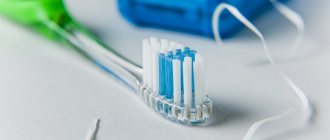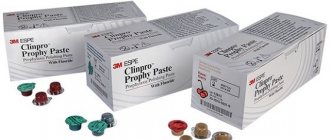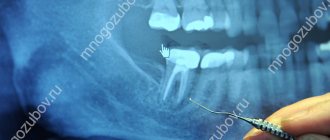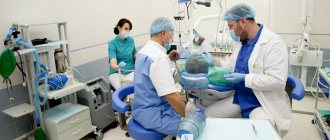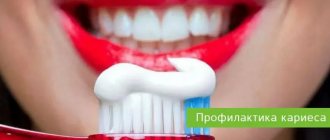The essence of the term “scaling”
Many patients are interested in what oral scaling is. This is a professional procedure (carried out exclusively in the dentist’s office) that allows you to clean the supragingival, cervical, subgingival area, and roots from hard deposits and plaques, which are usually called tartar. Translated from English, scaling means “descaling.” But very often, some clinics include the removal of soft deposits in this concept.
On a note! In some dentistry, the word scaling simply means comprehensive cleaning of the oral cavity. But it would be more correct to say that this is one of the stages of professional hygiene (cleaning) of the oral cavity.
In the classical sense, the procedure is carried out using ultrasonic instruments called scalers (scalers, scalers). But in addition to them, other devices and devices can also be used, for example, mechanical curettes.
Indications
In addition to the need for periodic monitoring of the condition of the oral cavity, factors determining the need for the procedure include:
- Planning the installation of fixing splints;
- Preparation for prosthetics or implantation;
- Installation of orthodontic correctors;
- Deterioration of the shade of the enamel coating of teeth.
Diagnosed gum pockets are a prerequisite for the development of more complex pathologies, which can be eliminated by timely scaling.
The need for the procedure
A biofilm consisting of saliva, food debris and various microorganisms continuously forms on the surface of the enamel. If a person brushes his teeth irregularly and not well enough, as well as other factors (poor diet, bad habits, internal diseases of the body, such as diabetes), then deposits begin to accumulate, layer on top of each other, and soft plaque quickly turns into hard plaque.
When is oral scaling performed?
At first, such plaque is deposited only on the crowns of the teeth and the surface of the gums, which spoils the aesthetics of the smile and leads to bad breath. But later it penetrates under the gums. Removing it at home becomes simply impossible, and generally unsafe. And if you don’t clean, the risk of developing caries, gingivitis and periodontitis increases.
Plaque under the gums is especially dangerous, because it becomes a source of toxins that inflame the gums, leading to the formation of deep periodontal pockets, purulent processes, destruction of periodontal tissue and the ligaments of teeth that hold them in the sockets. To prevent such conditions, treat them (including to avoid complex surgical procedures), and scaling can be performed in dentistry.
What types of procedures are there?
Depending on the type and location of plaque, there are supragingival and subgingival scaling. The second can be combined with procedures such as closed or open curettage of the gums, and also necessarily with root polishing.
Supragingival scaling and indications for its implementation
Plaque on the surface of the enamel and gums, as mentioned above, forms continuously. Absolutely no one is safe from it. Our diet, oral care habits, various diseases and bad habits (for example, smoking) make the smile unattractive, leading to the appearance of persistent pigmentation and discoloration, hard brown dental deposits along the gum line - they are best seen from the lingual side.
Supragingival scaling procedure
On a note! Indications for supragingival type of manipulation: prevention of caries and gum inflammation, as well as preparation for any medical and surgical procedures, for example, whitening, splinting, implantation, prosthetics, installation of braces, fluoridation and remineralization.
How do doctors deal with these types of plaque? Ultrasonic scaling or laser comes to the rescue in the fight against hard deposits. But the Air-Flow device, special brushes, threads and pastes cope well with soft plaque. After such a complex effect, the enamel becomes smooth, shiny, well-groomed, and acquires its natural shade. The procedure also perfectly prepares the oral cavity for better exposure to various strengthening and healing compounds.
Subgingival scaling and indications for its implementation
Such manipulation as subgingival scaling of dental plaque is indicated in the following situations:
- the presence of hard plaque under the gums, on the necks and roots of the teeth: in these areas there is no soft plaque. Typically, the presence of deposits is indicated by symptoms such as increased sensitivity, bleeding and swelling of the gums, periodontal pockets, detachment of the gum from the tooth, pus, bad breath, mobility and displacement of teeth,
- atrophy of the gums, exposure of the necks and roots of the teeth,
- gingivitis, periodontitis and periodontal disease: for their comprehensive treatment and prevention.
During the procedure, the doctor needs to carefully penetrate the subgingival pockets and clean them, for which ultrasound (special devices with scaler attachments) or laser are best suited. In addition, manual mechanical instruments (curettes[1]) are also used.
Application of the “Vector” device
It is important to emphasize that subgingival deposits, depending on their quantity and depth of location, can be removed in different ways:
- subgingival scaling, which is also called closed and non-surgical: it is used to gently and atraumatically clean periodontal pockets (if they are shallow, no more than 5-6 mm) and the root surface as much as possible. Can be effectively performed on the Vector machine using a special Vector Paro attachment,
- deep scaling: to better provide access to the roots and deposits (if they are very deep), doctors sometimes resort to surgical manipulations, peeling off the mucous membrane with a scalpel. The procedure is more complex and traumatic.
On a note! Ultrasound is good because it is non-contact and does not cause allergies. It breaks deposits into tiny particles, after which they are washed away without a trace with an aqueous solution. But the laser is considered even safer and more effective in use, since it simultaneously disinfects mucous membranes, prevents tissue bleeding, and accelerates regeneration processes after traumatic interventions. However, the laser procedure is more expensive.
After removing deposits from the roots of the teeth, it is important for the doctor to grind, polish and smooth these areas using special pastes. This measure will help prevent rapid re-formation of the stone. The procedure for root planing in dentistry is called root planning. An experienced doctor will definitely carry it out after scaling.
Does it hurt?
The procedure can be unpleasant, especially if the patient has sensitive teeth and sore gums. However, there is usually no talk about pain. To prevent discomfort, tissues are anesthetized before the procedure by applying a special freezing gel to them. If subgingival scaling is performed openly, with mucosal detachment and subsequent suturing, the procedure is performed under local anesthesia.
After the procedure, already at home, the patient may again experience discomfort. To reduce it to a minimum, and also to promote rapid tissue restoration, a diet is prescribed (without cold and hot, hard, salty and spicy), antiseptic, anti-inflammatory and regenerating drugs are prescribed.
How painful is it to do teeth scaling?
“I did scaling of the entire jaw. The doctor advised to treat periodontitis. Afterwards it was very unpleasant, my gums were very sore and itchy. At home I smeared them with Dent's Metrogyl. But 8 weeks have passed, and now the doctor notes that my condition has improved, the periodontal pockets have become significantly smaller, and this is worth a lot!”
Karma, review from the dental portal gidpozubam.ru
Question of price
The average cost of this procedure reaches 6,000 rubles. It is not so expensive compared to treatment or restoration of teeth using prosthetics.
Therefore, it is better to have a scaling every six months and have a shining healthy smile than to constantly visit the dentist and endure the unpleasant procedure of caries treatment.
And it’s even worse when tartar causes diseases such as periodontitis, which results in: unaesthetic appearance of teeth, bad breath, bleeding gums and tooth loss.
Benefits of subgingival scaling
The main goals of subgingival dental scaling are the prevention and treatment of periodontal inflammation by removing stone, microbial film, infected root cement and forming its smooth surface. The procedure allows you to get rid of the source of toxins and bacteria, relieve unpleasant symptoms (bleeding, swelling, soreness and itching of the gums).
Important! According to a number of studies, the treatment of periodontitis using the scaling technique can reduce the depth of periodontal pockets and the number of bacteria, and help restore natural gingival attachment.[2]
In case of advanced periodontitis and periodontal disease, in combination with other measures, it helps to transfer the disease into a stage of stable remission, serves as a prevention of the formation of new deposits, and helps to avoid displacement and premature loss of teeth.
Expert opinion
Marina Igorevna Tarabanovskaya
Specializations: Dentist-therapist, periodontist
Experience: 10+
“Subgingival scaling is one of the conservative types of treatment for periodontal diseases (in combination with other methods) and often allows one to avoid more complex surgical interventions. For example, flap operations to reduce deep periodontal pockets and correct gums.”
Scaling and curettage: the same thing?
Sometimes in different descriptions these two concepts mean the same thing. But actually it is not. If we turn to periodontics, then curettage is the scraping of the gingival wall of the periodontal pocket from granulations. What are granulations? Soft tissues subjected to a pathological inflammatory process.
Scaling involves the removal of hard dental plaque (if it is subgingival, then from under the gum, which is important in the case of periodontitis and periodontal disease) and is necessarily combined with the procedure for smoothing the root surface. Some of the actions carried out during these manipulations may include some stages of curettage. However, these two procedures should be considered as separate parts of periodontal treatment.[3]
For a better therapeutic effect, these two procedures can be performed sequentially. After them, the gums are initially bright red, swollen, and may bleed. But after just a few weeks, with proper hygienic care, the tissues acquire a natural pinkish color, their surface is evened out, and they adhere better to the teeth.
Before and after the scaling procedure
Air Flow - “Air flow”. Removing dark plaque.
Colored plaque settles on the surface of the teeth. The appearance of plaque is promoted by drinking coffee, red wine and smoking.
How does the procedure work? The dentist points the device at the plaque-covered surface of the teeth. Under high pressure, the teeth are treated with a mixture of powder (sodium bicarbonate) with air and water spray. The powder removes plaque, bacteria and dental plaque even in hard-to-reach places where other tools cannot penetrate.
What is the result? The procedure returns the teeth to their natural color. They become light and shiny. For 2-3 hours after cleaning your teeth using the Air Flow method, you should not smoke, drink tea, coffee or eat foods that can stain your teeth.
How often to do it. It is recommended to carry out this treatment twice a year. Before doing the procedure, consult with your doctor: for some periodontal diseases, other methods of removing dental plaque are preferable.
